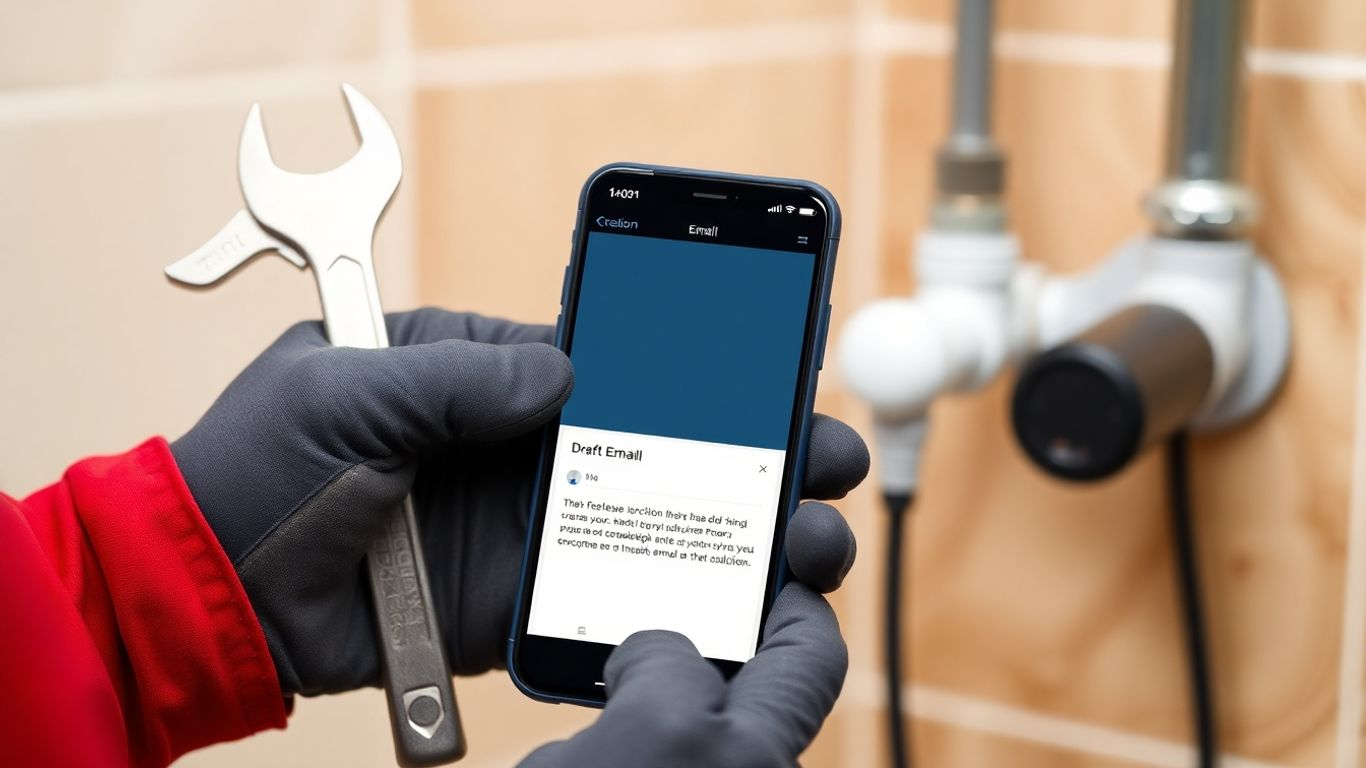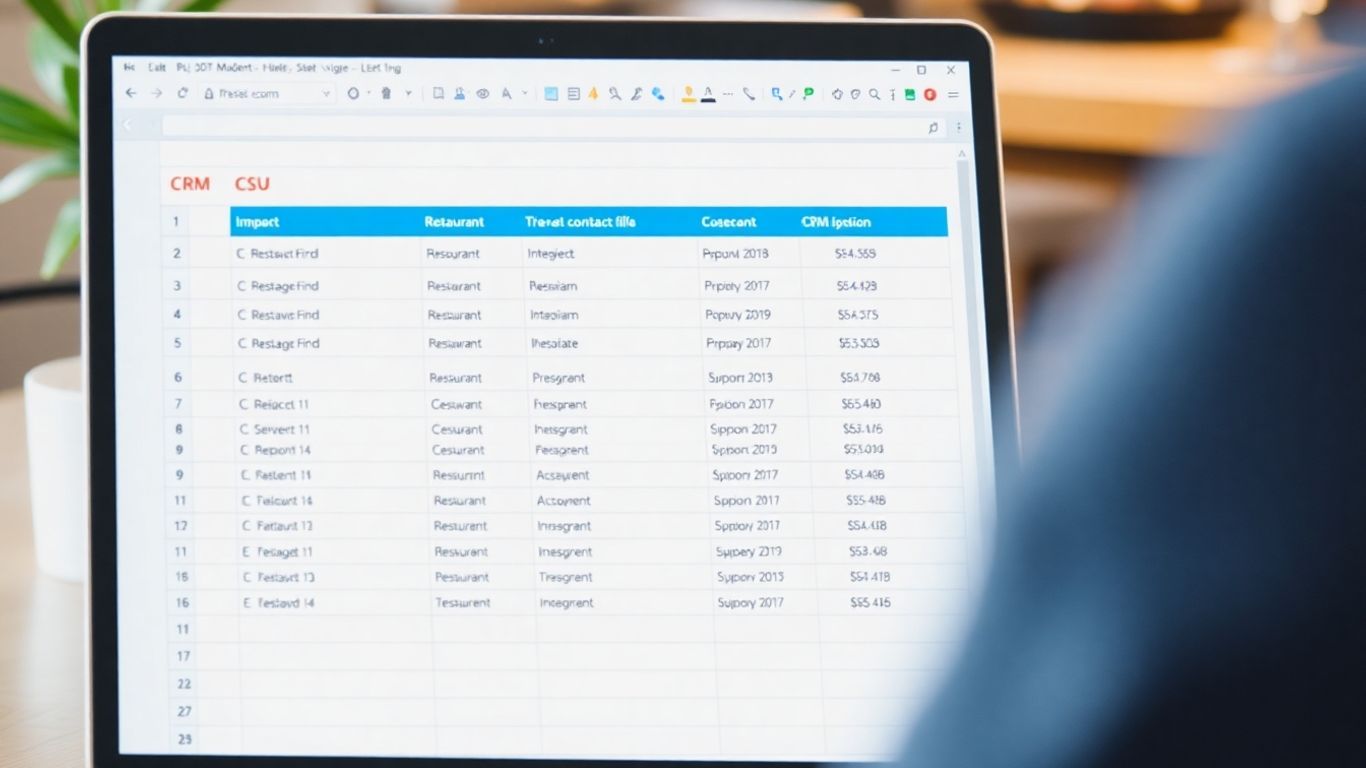Effective Cold Email Templates for Plumbing Companies
Blog Author - Published Date
Reaching out to plumbing companies with a cold email can feel a bit tricky. You want to get their attention without being annoying, right? It’s all about showing you get their business and have something helpful to offer. Think of it like this: you wouldn't walk into a shop and just start yelling about your services. You’d try to connect first. That’s what we’re aiming for here – making a real connection that might lead to them needing your help. We'll cover how to find the right people, what to say, and how to make sure your message actually gets read.
Key Takeaways
- Before you write, really get to know who you're emailing. Find out what plumbing companies are dealing with day-to-day. This helps you figure out their problems.
- Make your subject line pop. It needs to be short, clear, and make them want to see what's inside. Personal touches here go a long way.
- Don't send the same email to everyone. Tweak your message for each company. Mentioning something specific you know about them makes a big difference.
- Keep your emails brief and to the point. Focus on how you can help them solve their problems, not just what you do. Using a plumbers contact list can help you target effectively.
- Always tell them what you want them to do next. Make it simple, like asking for a quick chat or a quote, so they know exactly how to respond.
Understanding Your Plumbing Audience
Before you even think about writing an email, you need to know who you're talking to. Sending out generic messages to plumbing companies across the USA is like throwing darts in the dark – you might hit something, but probably not what you're aiming for. We're talking about busy business owners and managers here, people who deal with leaky pipes and clogged drains all day. They don't have a lot of time for fluff.
Identifying Target Plumbing Companies
Think about the kind of plumbing businesses you want to work with. Are they small, family-run operations? Or are they larger companies with multiple crews? Maybe you're looking for those specializing in commercial work, or perhaps residential is more your speed. Knowing this helps you tailor your message. For instance, a small shop might be more concerned about immediate cash flow, while a larger one might be focused on scaling their operations or improving efficiency.
Researching Their Specific Pain Points
What keeps these plumbers up at night? It could be finding reliable plumbing leads USA, managing their schedule effectively, dealing with difficult customers, or keeping their vans stocked. If you offer a service that directly addresses one of these issues, you've got a hook. For example, if you provide a lead generation service, you can talk about how you help them find more customers. If you offer scheduling software, you can discuss how it reduces no-shows and optimizes routes.
Here's a quick look at common challenges:
| Challenge Category | Specific Pain Points |
|---|---|
| Customer Acquisition | Finding consistent, quality leads |
| Operations | Scheduling conflicts, inefficient routing, managing inventory |
| Workforce | Staff shortages, training new hires, employee retention |
| Technology | Outdated software, lack of digital presence |
Understanding Market Trends for Plumbers
What's happening in the plumbing world right now? Are there new regulations affecting how they operate? Is there a surge in demand for certain services, like tankless water heater installations or smart home plumbing tech? Staying on top of these trends allows you to position your offering as timely and relevant. For example, if there's a growing demand for water conservation services, and you offer a product that helps with that, you can highlight it.
It's not just about what you sell; it's about understanding the landscape your prospect operates within. This knowledge makes your outreach feel less like a sales pitch and more like a helpful conversation.
Crafting Compelling Subject Lines

Think of your subject line as the bouncer at the club for your email. If it doesn't look good or say the right thing, nobody's getting in. For plumbers, this means cutting through the noise of a busy inbox. We're not just talking about getting opened; we're talking about getting opened by the right person who actually needs what you're offering.
Creating Concise and Attention-Grabbing Lines
Nobody has time to read a novel in their inbox preview. Keep it short, sweet, and to the point. Think about what would make you pause and click. A good rule of thumb is to aim for under 50 characters if possible. It’s about sparking interest quickly without giving everything away.
- Focus on a specific benefit: What problem do you solve?
- Use numbers or data: If you have a stat, use it.
- Keep it clear: Avoid vague language.
The goal here is to make the recipient think, "Hmm, that's interesting," rather than "Ugh, another sales pitch."
Personalizing Subject Lines for Impact
Generic subject lines get ignored. Period. Plumbing companies, like any business, appreciate it when you show you've done your homework. Mentioning their company name or a specific service they offer can make a huge difference. It shows you're not just blasting emails to everyone.
- Company Name + Benefit: "Smith Plumbing: Faster Drain Clearing"
- Referencing a Pain Point: "Tired of Clogged Drains, [Company Name]?"
- Mentioning a Service: "Improving [Company Name]'s Water Heater Efficiency"
Using Urgency and Curiosity Effectively
Sometimes, a little nudge is all it takes. Creating a sense of urgency or piquing curiosity can encourage that click. This doesn't mean being pushy, but rather hinting at something they might miss out on or a question they'll want answered.
- Curiosity: "A Quick Question About Your Service Fleet"
- Urgency (use sparingly): "Limited-Time Offer for Local Plumbers"
- Benefit + Curiosity: "See How [Competitor Name] Saved on Plumbing Leads"
Remember, the best subject lines are often a mix of these strategies. Test different approaches to see what works best for the specific types of plumbing businesses you're targeting.
Personalization Strategies for Plumbers

Sending a generic email to a plumbing company is like showing up to a job without the right tools – it’s just not going to work. Plumbers are busy people, and they get a lot of emails. To stand out, you really need to show you’ve done your homework.
Tailoring Emails to Individual Plumbing Companies
Think about it: if someone sent you an email that clearly showed they knew your business, your name, and maybe even a recent project you completed, wouldn't you be more likely to read it? That’s the goal here. Before you even start typing, spend a few minutes looking up the company. Check out their website, their social media, or even local news. See what they’re up to. Are they expanding? Did they just finish a big job? Mentioning something specific like, "I saw your team recently completed the plumbing for the new downtown library," shows you’re not just blasting out emails to everyone. It makes them feel seen and understood.
Highlighting Shared Connections or Interests
People do business with people they know, like, and trust. If you have any common ground, bring it up. Maybe you both attended the same industry conference, or you know a mutual contact. Even something as simple as, "I noticed you’re also a fan of [local sports team]," can create a small bridge. It’s about building a human connection before you even get to the business part. This approach can really help [build rapport and trust].
Referencing Recent Achievements or News
Did the plumbing company you’re emailing just get a great review online? Did they announce a new service? Congratulate them! A simple, "Congratulations on your recent award for outstanding customer service," can make a big difference. It shows you’re paying attention and genuinely interested in their success, not just trying to sell them something. It’s a small gesture, but it can make your email much more memorable.
Here’s a quick way to organize your research:
| Company Name | Recent Achievement/News | Potential Connection |
|---|---|---|
| Plumbing Co. A | Launched new emergency service | Mention their commitment to rapid response |
| Plumbing Co. B | Featured in local paper | Congratulate them on the press coverage |
| Plumbing Co. C | Expanded service area | Acknowledge their growth and reach |
Remember, personalization isn't just about filling in blanks. It's about showing genuine interest and understanding the specific context of the plumbing business you're contacting. This thoughtful approach is what separates a good cold email from one that gets ignored.
Structuring Your Cold Email Content
Alright, so you've got a killer subject line and you've done your homework on the plumbing company. Now, how do you actually put the email together so it doesn't just get deleted? It's all about being clear, direct, and showing them you understand their world.
Keeping the Message Concise and Readable
Nobody wants to read a novel in their inbox, especially not a busy plumber. Think short sentences, short paragraphs. Get straight to the point. If you can say it in one sentence, don't use three. The goal is to make it easy for them to scan and understand what you're offering. Imagine you're trying to explain something to a friend who's got a million things going on – you'd be brief, right? That's the vibe.
Focusing on Benefits and Solutions Offered
Plumbers are practical people. They want to know how you can make their life easier or their business better. Instead of listing features of your product or service, talk about the results. For example, don't just say "Our scheduling software has advanced features." Instead, say "Our software can cut down your scheduling time by 2 hours a week, meaning more time for jobs and less time on the phone."
Here’s a quick way to think about it:
- Problem: What's a common headache for plumbers? (e.g., missed appointments, inefficient routing)
- Solution: How does your offering fix that specific problem?
- Benefit: What's the tangible outcome for them? (e.g., more jobs completed, less fuel used, happier customers)
Think about what keeps a plumbing business owner up at night. Is it finding reliable staff? Managing job schedules? Getting paid on time? Your email should touch on these points and show how you can be the answer.
Incorporating Social Proof and Testimonials
People trust what other people say. If you've helped other plumbing companies, let them know. A short testimonial or a mention of a similar company you've worked with can go a long way. It builds trust and shows that you're not just blowing smoke. You could say something like, "We recently helped 'Reliable Pipes Inc.' reduce their customer complaint calls by 30% in just one quarter." It’s about showing, not just telling, that you can deliver results. You can find some great examples of how to structure these emails on cold email examples.
Remember, the structure of your email should guide the reader smoothly from understanding you're relevant to wanting to take the next step. Keep it clean, focused on them, and easy to digest.
The Importance of a Clear Call to Action
So, you've written a great email. It's personalized, it hits on their pain points, and it's easy to read. But what happens next? If you don't tell them what you want them to do, they probably won't do anything. That's where the call to action, or CTA, comes in. It's basically the whole point of the email, right? You want them to take a specific step.
Guiding Prospects to the Next Step
Think of your CTA as the signpost at the end of a trail. Without it, people might just wander around, unsure of where to go. For plumbers, this could be anything from scheduling a quick chat to requesting a quote for a specific service. The goal is to make it obvious what the very next, easiest step is. Don't leave them guessing. A clear CTA removes friction and guides them smoothly towards engaging with you further. It's about making it simple for them to say 'yes' to the next interaction.
Making Your Ask Specific and Easy
When you're asking a busy plumber to do something, you need to be super clear and make it as painless as possible. Instead of saying 'Let me know if you're interested,' try something like 'Would you be open to a 15-minute call next week to discuss how we helped [Similar Company] reduce callbacks by 20%?' This is specific, it mentions a benefit, and it sets a clear time expectation. You could also offer a direct link to your scheduling calendar or a specific resource. The easier you make it for them to respond, the more likely they are to actually do it.
Encouraging Dialogue Over Immediate Commitment
Sometimes, asking for a big commitment right away can feel like too much. For plumbing companies, they might be hesitant to agree to a full consultation without knowing more. In these cases, a softer CTA can work wonders. You could invite them to reply with a specific question, ask for their thoughts on a particular industry trend, or suggest they download a helpful guide. This opens the door for a conversation without demanding an immediate decision. It's about building rapport and trust, one step at a time.
Here are a few ways to phrase your CTAs:
- "Are you available for a brief 10-minute call on Tuesday or Wednesday to explore this further?"
- "Would you be interested in seeing a quick case study relevant to your business?"
- "What are your thoughts on [specific industry challenge]?"
A well-placed CTA is the engine of your cold email. It transforms passive reading into active engagement. Without it, even the most compelling message can fall flat, leaving potential opportunities unexplored. Make it count.
Optimizing Your Outreach for Plumbers
So, you've got your cold email templates for plumbers ready to go, and you've built a solid plumbers email list. That's a great start, but the real work begins now: making sure your outreach actually gets results. It's not just about sending emails; it's about sending the right emails to the right people at the right time, and then knowing what to do next.
Tracking Email Performance and Response Rates
Sending emails into the void isn't very helpful, is it? You need to know what's working and what's not. This means keeping an eye on a few key metrics. Open rates tell you if your subject lines are doing their job. Click-through rates show if your message is compelling enough to make them want to learn more. And, of course, reply rates are the ultimate goal – they show that your email is sparking interest.
Think of it like this:
- Open Rate: Did they even notice your email?
- Click-Through Rate: Did something in the email make them want to take a look?
- Reply Rate: Did they feel compelled to respond?
Using tools that track these numbers is pretty standard now. It helps you see which subject lines get the most opens or which calls to action get the most clicks. You can even see if certain parts of your message are being ignored. This data is gold for refining your approach.
Implementing Respectful Follow-Up Protocols
Most people don't respond to the first email they get, especially if it's a cold outreach. That's totally normal. The trick is to follow up without being annoying. A good rule of thumb is to wait a few days – maybe three to five business days – before sending a follow-up. Keep it short and sweet, just a gentle reminder that you're still there and still have something that might help them.
Here’s a simple follow-up structure:
- Briefly reference the previous email: "Just wanted to follow up on my email from last week regarding [topic]."
- Reiterate the core benefit: "We help plumbing companies like yours [mention key benefit]."
- Offer a low-commitment next step: "Would you be open to a quick 10-minute chat next week?"
Remember, the goal is to keep the conversation going, not to demand a sale. You're building a relationship, and that takes patience. If you're looking for more ideas on how to connect with businesses, this guide on email marketing strategies for HVAC businesses might offer some useful insights.
Leveraging Tools for Efficient Prospecting
Manually sifting through potential leads and sending individual emails can take forever. Thankfully, there are tools that can make your life a lot easier. CRM systems help you organize your plumbing company contact list and track interactions. Email automation platforms can help you send out your cold emails and follow-ups on a schedule, freeing you up to focus on other parts of your business. Some tools even help you find contact information for the right people at plumbing companies. Using the right technology can seriously speed up your outreach process and make it much more effective. It’s about working smarter, not just harder, when you’re trying to connect with potential clients through a cold email to plumbing companies.
The key to successful outreach isn't just about having a great cold email template for plumbers. It's about the consistent effort, the smart use of data, and the respect you show for the recipient's time. By tracking your results and following up thoughtfully, you can turn those initial cold contacts into real business opportunities.
Wrapping Up Your Cold Email Strategy
So, we've gone over how to actually write these emails, from making sure the subject line grabs attention to keeping the message short and personal. It’s not about sending out a million generic emails and hoping for the best. It’s more about doing a little homework, showing you understand what a plumbing company might be dealing with, and then clearly explaining how you can help. Remember to always include a clear next step, like asking for a quick chat or a quote. Keep at it, track what works, and don't be afraid to tweak your approach. Getting those first few responses can feel like a win, and with practice, you'll get better at connecting with potential clients.
Frequently Asked Questions
Why should I send cold emails to plumbing companies?
Sending cold emails is a smart way to tell plumbing companies about your services. You can reach people who might not know they need you yet and show them how you can help with their plumbing problems.
What makes a good subject line for a plumbing company email?
A good subject line is short, grabs attention, and tells them what's inside. Try using their name or mentioning a common plumbing issue you can fix. It's like a catchy headline for your email.
How do I make my email personal for a plumbing business?
To make it personal, do a little homework first. Find out something specific about their company, like a recent job they did or something they posted online. Mentioning this shows you care and aren't just sending the same email to everyone.
What should I write in the email body?
Keep it brief and easy to read. Focus on how your service can solve their problems or make their life easier. Think about what benefits you offer, like saving them time or money. Using simple words is best.
What's a 'call to action' and why is it important?
A call to action tells them what you want them to do next, like 'visit our website' or 'schedule a quick chat.' Make it clear and simple so they know exactly how to respond if they're interested.
Should I follow up if I don't get a reply?
Yes, it's okay to follow up politely. People are busy, and they might have missed your first email. A gentle reminder can make a big difference. Just don't send too many emails.














